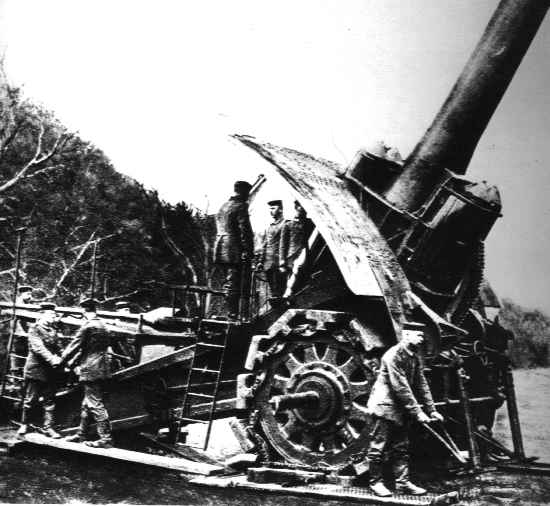

In case you thought Big Bertha was the name of
a large opera singer, let's set the record straight. A search for
rail guns on the internet will inevitably reveal information about World
War I and WWII guns that were mounted on rail tracks in order to facilitate
transport. With such mobility their size grew accordingly and Big
Bertha, pictured to the  left,
is an example of one such gun used by the German army during its days long
advance through Belgium's frontier fortresses in the summer of 1914 (click
here for info about big guns). The propulsion mechanism in these
guns is that with which we are familiar: gun powder. The rail gun
I will be demonstrating is quite different. Instead of gun powder,
electricity is used for propulsion. Revealing the associated principles
of electricity (and magnetism, as we shall see) is the purpose of the demonstration.
The reason it is called a rail gun is that the projectile slides along
conducting rails. The name has nothing to do with railroad tracks
in this case.
left,
is an example of one such gun used by the German army during its days long
advance through Belgium's frontier fortresses in the summer of 1914 (click
here for info about big guns). The propulsion mechanism in these
guns is that with which we are familiar: gun powder. The rail gun
I will be demonstrating is quite different. Instead of gun powder,
electricity is used for propulsion. Revealing the associated principles
of electricity (and magnetism, as we shall see) is the purpose of the demonstration.
The reason it is called a rail gun is that the projectile slides along
conducting rails. The name has nothing to do with railroad tracks
in this case.
I don't want to belabour the point that such technology can be used for lethal weapons against humans. We should all hope that some day such a purpose will vanish (peace on Earth!). At the same time, however, it serves no purpose for us to feign ignorance, and there are intriguing stories on the subject of big guns, so please let me tell you the story of Gerald Bull. This Canadian born designer is infamous for having an obsession with building the very best artillery. He was willing to go to such lengths to achieve this aim that in the early 1980's, shortly after the beginning of the Iraq-Iran war, he started working for the Iraqi government and the defense minister at the time, Saddam Hussein. Iraq was not an enemy of the western countries at the time and this work was tolerated, but what people didn't know is that Bull was working on a very unconventional weapon: the Iraqi Supergun. The project, if it had been successful, would have created a gun capable of firing a 600 kg (1320 lbs) projectile 1000 km, or, even more threatening, a rocket assisted projectile into orbit. From orbit it is possible to hit a target anywhere on the planet, and if it were equipped with a nuclear warhead, one can imagine the consequences. Another purpose for the gun would have been disabling spy satellites. Project Babylon was not successful, however, because Gerald Bull was assassinated outside his apartment in Brussels, Belgium in 1990. The assassin was never found, but the Israeli intelligence agency, Mossad (Hebrew for "institution"), is suspected to be responsible. Gerald Bull had also worked for Israel before his association with Iraq, so Israel knew his design capabilities, and, therefore, realized the threat his work for Iraq posed to Israeli security. For a more complete account of the Gerald Bull story, please click here, or watch the movie "Doomsday Gun", with Kevin Spacey.
There have been no practical rail guns built. It is still only in the design stages (for example, at the University of Texas at Austin). If one is finally perfected, its civilian uses will include being a cheap method for propelling small satellites into space, provided they are built strong enough to withstand the many g-forces that would be exerted during firing. The rail gun is worth researching because of its enormous potential. The US military would consider it as a substitute for its Patriot missiles. A projectile fired from a rail gun would reach maximum speed within milliseconds, whereas the chemical propellant that accelerates the Patriot missile takes some time to burn, and maximum speed is reached only after this is finished. During the time taken for burning, the target missile has moved a significant distance and the Patriot missile's original trajectory needs to be changed using a guidance system to put it back on an intercept path with the target missile. Such guidance systems aren't perfect and reduce the reliability of Patriot missiles. A rail gun projectile, however, would intercept the target missile almost immediately after the trigger is pulled, meaning the gun can be aimed directly at it, thus improving accuracy. The advantage of rail guns is the high speed of their projectiles.
There are many significant problems that need to be overcome before a practical rail gun can be built.
To see the model,
please click here.